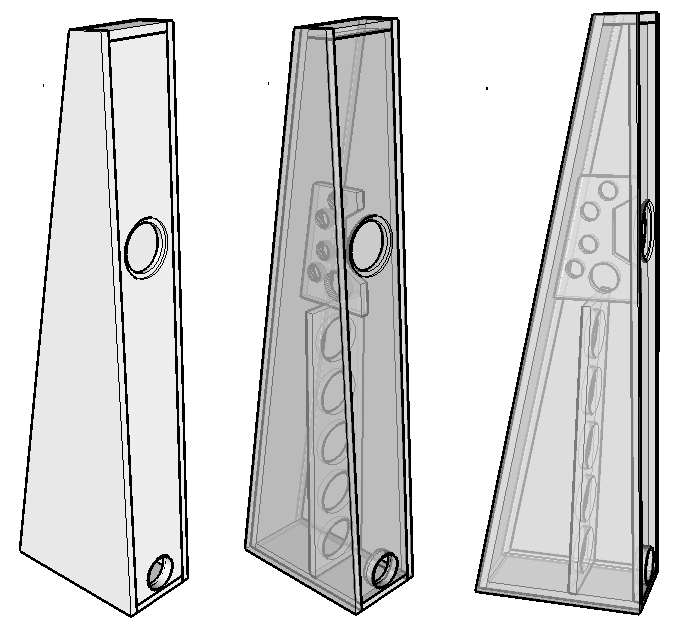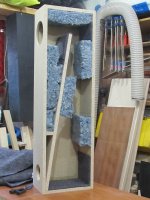Gorgeous build. Looks stunning.RK1, the grill is heavily bevelled inside and out and sits on top of the driver frame. It acts like a short waveguide.
Larry
Recently completed project, Alpair 10.2 tapered folded MLTL.
Larry
I concur, very nice work Larry!
got some pictures during the build?Squeak, I used the bezel covers and added a beveled wood ring, covered that with cloth. It's a snug fit on the driver frame, no need for fasteners or magnets.
Thanks Mark!
Larry
Thanks for all the kind words! I worked for a large door company which closed, most all the materials they had on hand went to the trash (my house). I have thousands of sq ft of p-lam and veneer plus other materials for speaker building!
Chris, I have only one pic of the "inards"!
Chris, I have only one pic of the "inards"!
Attachments
I have thousands of sq ft of p-lam and veneer plus other materials for speaker building!
Wow!

jeff
Alpair 10.2 tapered folded MLTL.
From the interior picture it is clearly a folded ML-Voigt, not an MLTL (as usually defined)
dave
I drew the original full size so no drawing! Inside dimensions are, 38.5 high 10.5 deep 6.5 wide center divider is 34 long and 4.875 from front, top, back. Material is .75 thick driver is 5.5 down from outside top, port is 3in dia. X 3in long and 4 up from outside bottom. The divider bottom piece is 26 down from inside top and 1.625 X 6.5. I think the bevel is 8 degrees. This is a bit large for the 10.2 but was intended to work with the 10p and 10.3.
Hope this helps.
Larry
Hope this helps.
Larry
MLTL vs BR --And The Difference Is?
Chris first let me say your speakers are beautiful. However when I saw the picture of it's "inards" it brought to mind a question I've always had about MLTL like this. And yes this is a sincere question from someone who doesn't understand the concept and is trying to! I'm wondering if someone will explain to me just what the slanted board inside the cabinet of Larry's beautiful speakers actually does? I could understand it's purpose "if" for example:
In this scenario the rear-wave of the driver would travel down the slanted board compressing as the wave reaches the bottom of the board. Then the wave would turn around the end of the slanted board compressing more and more as it starts traveling the slanted board until it finally reaches the rear "port" and exists the cabinet. In this case I understand perfectly why the slanted board is installed i.e., it adds the length of the rear-wave. However when both driver and port are on the same side of the slanted board as I see in a typical MLTL I just don't understand the slanted boards purpose.
I'm hoping someone here can explain it's purpose in an easy to understand manner to me? Because I just don't understand how it can add to the rear-wave, when the driver and the port are on the same side of the slanted board. To me this is no different than a regular BR enclosure.
Thanks...
Thetubeguy1954 (Tom Scata)
Thanks for all the kind words! I worked for a large door company which closed, most all the materials they had on hand went to the trash (my house). I have thousands of sq ft of p-lam and veneer plus other materials for speaker building!
Chris, I have only one pic of the "inards"!
Chris first let me say your speakers are beautiful. However when I saw the picture of it's "inards" it brought to mind a question I've always had about MLTL like this. And yes this is a sincere question from someone who doesn't understand the concept and is trying to! I'm wondering if someone will explain to me just what the slanted board inside the cabinet of Larry's beautiful speakers actually does? I could understand it's purpose "if" for example:
- we placed the driver exactly opposite the port on what's now the rear of the cabinet.
- we flipped the speakers upside-down, making what's now the top of the cabinets the bottom.
- we turned the speakers around so that the driver faces towards us and the port is exactly opposite on the rear of the cabinet.
In this scenario the rear-wave of the driver would travel down the slanted board compressing as the wave reaches the bottom of the board. Then the wave would turn around the end of the slanted board compressing more and more as it starts traveling the slanted board until it finally reaches the rear "port" and exists the cabinet. In this case I understand perfectly why the slanted board is installed i.e., it adds the length of the rear-wave. However when both driver and port are on the same side of the slanted board as I see in a typical MLTL I just don't understand the slanted boards purpose.
I'm hoping someone here can explain it's purpose in an easy to understand manner to me? Because I just don't understand how it can add to the rear-wave, when the driver and the port are on the same side of the slanted board. To me this is no different than a regular BR enclosure.
Thanks...
Thetubeguy1954 (Tom Scata)
Tom, note that the vent on Larry's speakers, reaches thru the divider. Ignoring room loading effects, it could be front or rear facing withno differences.
One dimension (length) is much longer than any of the others which changes the physics from a BR to a quarter-wave (TL).
dave
One dimension (length) is much longer than any of the others which changes the physics from a BR to a quarter-wave (TL).
dave
Search for TQWT (Tapered Quarter Wave Tube) or Voigt pipe and I think you'll find more than enough theory and mathmatics behind the slanted board. In Larry's speakers, the pipe is folded but below is what it would be like unfolded.

Hi chuyler!
It's amazing how just the right set of words or photos can clarify what was previously unfathomable. From this photo you provided chuyler. It would now appear to me this type of cabinet simply acts much like a tuned "pipe" would behave! A perfect example would be like the pipes in a church's organ are tuned. Am I correct in this initial assumption? If I am thank you for clarifying what was ---{at least up to now}--- a very difficult concept for me to grasp for some reason.
Thetubeguy1954 (Tom Scata)
- Home
- Loudspeakers
- Full Range
- Full Range Speaker Photo Gallery


